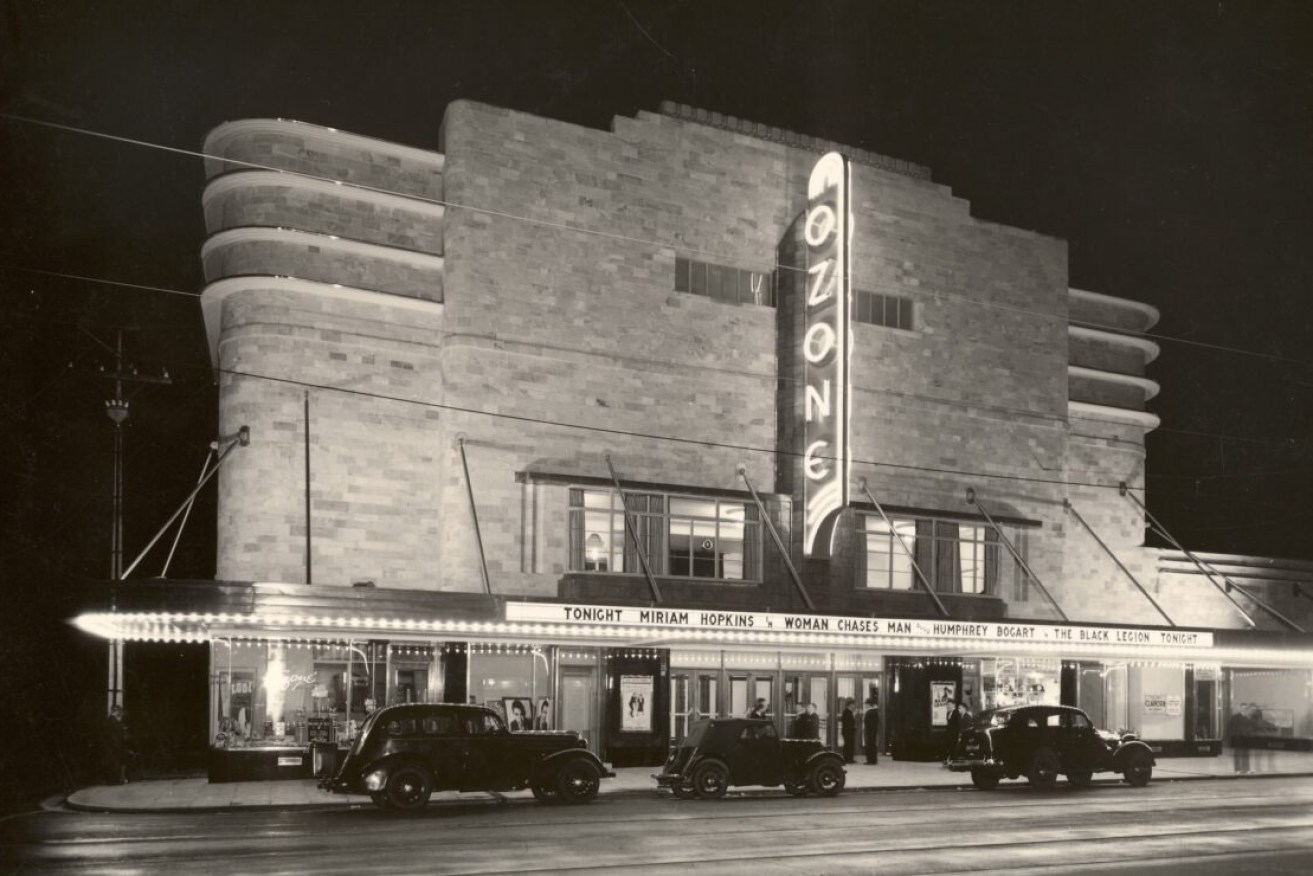‘Now showing’ – celebrating Adelaide’s cinema heyday
An exhibition showcasing Adelaide’s oldest movie cinemas not only shines a light on their important architectural contribution to South Australia, it also reflects their significance as glamorous social hubs over the decades.


The Glenelg Ozone Picture Theatre in 1937. Photo: D Darian Smith, Garnaut collection S308, Architecture Museum, University of South Australia
The architecture and old-world glamour of Adelaide’s oldest movie cinemas are celebrated in a new exhibition which forms part of South Australia’s History Festival.
Now Showing… Cinema Architecture in South Australia – at the Kerry Packer Civic Gallery – includes photographs and architectural drawings of some of the state’s most spectacular cinema showpieces including the Piccadilly in North Adelaide, the Capri in Goodwood and the former Ozone Theatre in Victor Harbor.
The exhibition, presented by The Bob Hawke Prime Ministerial Centre and Architecture Museum at the University of South Australia, has been curated by Julie Collins, Naomi Giles, Susan Lustri and Susan Avey.

The Goodwood Star (later Capri) Picture Theatre opened in 1941. Photo: D Darian Smith / Garnaut collection, S308, Architecture Museum
Collins says the idea for the exhibition came out of a similar event held last year which celebrated the state’s department store architecture.
“There was a family at that exhibition who had brought their grandmother along and she was chatting about her memories of old buildings, and the ones she remembered the most were old picture theatres. I just happened to bump into them in the gallery when they were coming through and she said, ‘Wouldn’t it be great to see old photos of picture theatres on the walls?’ And I said, ‘That sounds like an excellent idea. I think we might just do that’.
“It is lovely just seeing multigenerational visitors to these kinds of historical exhibitions and seeing how grandparents and parents and children can actually connect through buildings and through their reminiscences across different eras. It’s a way that they can come together and talk and share these moments.”
Collins and her co-curators researched the museum’s extensive collection, including photographs, architectural plans and documents showcasing suburban, city and regional cinemas.

Julie Collins is one of the curators of the nostalgic cinema exhibition.
Some of the gems that form part of the exhibition include the old Melba cinema in Dulwich, which is now a retail outlet; The Regent in Rundle Mall, which now houses Dymocks book store and Regent Arcade; the York in Rundle Street; the Port Lincoln Civic Centre; the Glenelg Ozone Picture Theatre; the Hindmarsh Town Hall and West’s Olympia Picture Theatre in Hindley Street.
“We really tried to get a spread of picture theatres from across the metro, city and country areas, as well as a range of time periods,” Collins says. “But the major period for cinema design was really the 1930s and 1940s era. That’s when cinema was really the prime entertainment.
“That’s when everybody went to the movies for a night out and it was a way of dressing up and meeting people and socialising. They didn’t have television back then either, so it was a treat to see any kind of moving visuals and it was also the way people got their news, watching the newsreels before the feature started.”
The exhibition not only showcases different architectural features of these iconic buildings over time, it also reflects the way cinemas became social and cultural hubs.
“In the early 1920s when there were silent movies, the buildings were very decorative, almost Art Nouveau, with quite a lot of heavy decoration,” Collins says.
“Then, with the advent of the talking pictures, or ‘talkies’ as they became known, which was in that kind of 1930s period, that’s when cinemas really started to show the modern Art Deco style, becoming very much future-focused, with streamlining and curved forms, horizontal lines and ocean liner-inspired designs.

The Piccadilly opened in 1940 in North Adelaide. Photo: D Darian Smith / Garnaut collection, Architecture Museum
“So, when you think of theatres like the Capri and the Piccadilly, they had that real Art Deco and Moderne style, and they were really a luxury building. They’d have wall-to-wall carpet, quite often in the public areas with a lounge and snack bar. They also had the bright neon lights and the mirrors, so these buildings brought that Hollywood glamour to South Australia during the 1930s and ’40s.
“Picture theatres also added much to the streetscape of towns, with large entrances and lots of glass doors and windows, plus they had sublet shop tenancies on the ground level, so they were activating that space, both during the day and at night when they’d have the cinemas operating, so they actually brought an almost 24-hour economy to the streetscape.

Picture theatre projection room, Adelaide. Photo: D Darian Smith / Garnaut collection, Architecture Museum
“That was part of the attraction of going to the pictures, as well. The fact that you got to have an experience. It’s not just going to a dark room with a screen; you’re going there because of the building itself, and the foyer and the lobby and the grand staircases all added to a glamorous experience.”
The exhibition also taps into the nostalgia of old-fashioned service at the cinema, when the manager would often greet people in the foyers wearing a dinner jacket. An organ player, or in some cinemas an orchestra, would play live music before the feature movie started.
Adelaide’s premier theatre architect in the 1920s and ’30s was Chris A Smith, who designed several of South Australia’s cinema buildings including the Capri and the Hindmarsh Town Hall.
Collins says while it’s a shame many of the old cinemas have been knocked down, some – such as the Ozone in Victor Harbor – have been heritage-listed and still retain the spectacular Art Deco fixtures and fittings. She says the buildings are not only beautiful and architecturally significant, they were also often well built, meaning they have stood the test of time and can be repurposed and revitalised today.
“I think part of the appeal of these buildings is nostalgia but also the fact that quite often they were well designed and constructed. They were expensive buildings to build at the time and, because of that, they’ve actually stood the test of time and are robust enough that the adaptive reuse of these buildings is a distinct possibility.
“Picture theatres quite often had large spaces and, I mean, if you go to the old Regent in Rundle Mall, which upstairs is now a book shop, and you look up, you can still see the ornamental plaster work on the ceiling and walls.

Regent Theatre renovations, December 1940. Photo: Ellis collection S192, Architecture Museum
“Some of these buildings are protected. For example, the West’s Olympia Theatre on Hindley Street is now home to the Adelaide Symphony Orchestra, so that’s being reused.
“But we’ve lost a few such as the Glenelg Ozone Picture Theatre, which opened in 1937 on Jetty Road; that was a bit of a tragedy that it got demolished relatively recently. That was a beautiful Art Deco building made of stone with chrome fins and curvaceous lines. It’s heartbreaking and wasteful when we lose buildings which are not only beautiful but which, with a bit more imagination, could be adaptively reused.”
Now Showing… Cinema Architecture in South Australia is at the Bob Hawke Prime Ministerial Centre’s Kerry Packer Civic Gallery at the City West campus of the University of South Australia until May 30.

Regent Theatre renovations, December 1940. Photo: Ellis collection S192, Architecture Museum

Regent Theatre renovations, December 1940. Photo: Ellis collection S192, Architecture Museum
This article is republished from InReview under a Creative Commons licence. Read the original article.
InReview is an open access, non-profit arts and culture journalism project. Readers can support our work with a donation. Subscribe to InReview’s free weekly newsletter here.
![]()




